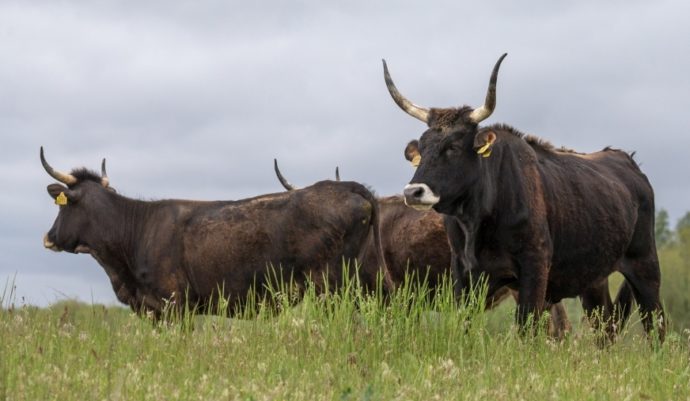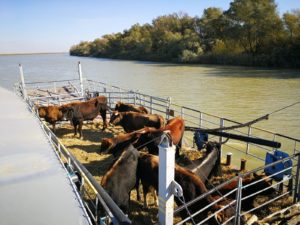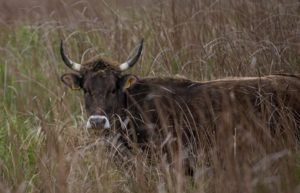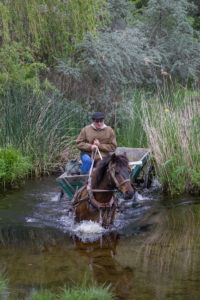The successful translocation saw a second group of ten Tauros join the existing herd, which arrived in the Danube Delta in 2015. Crossbreeding with local breeds should result in a free roaming, well-adapted herd of bovines that will shape a biodiverse, naturally grazed delta landscape.

A new shipment of Tauros arrived safely in the Danube Delta rewilding area in early November. The group of 10 animals, comprising eight heifers and two bulls, were transported from the Dutch breeding centre in Keent (six animals) and the Kempen-Broek Reserve, one of the European Rewilding Network member sites in the Netherlands. The animals are part of the European Wildlife Bank operated by Rewilding Europe. Despite the three-day journey, all the animals were found to be in a healthy condition on disembarkation.

This is the second shipment of Tauros to the Danube Delta, with these 10 animals joining a group of eight already at the rewilding area. The first shipment of 12 adult Tauros was made in 2015. Due to difficult local conditions and problems with acclimitisation – especially with older individuals – seven of these animals died. However, three calves were born last year and are now doing well.
This new shipment represents part of the Tauros breeding programme which is managed by the Taurus Foundation in cooperation with Rewilding Europe. The aim of the programme is to bring back a functional, wild version of the auroch – called the Tauros – by establishing viable wild populations of this impressive animal in several European locations. This, in turn, will boost the role of the Tauros as a natural grazer and benefit biodiversity through the creation of biodiversity-rich mosaic landscapes across the continent.
The journey by road from the Netherlands saw the Tauros unloaded every 24 hours to be fed and given a medical check. On arrival in the Romanian village of Murighiol, in the heart of the Danube Delta, the animals were loaded onto a barge for a four-hour voyage to their new home of Sfântu Gheorghe, a village situated at the mouth of the Danube .
“We are very happy with the condition of the new animals,” says Razvan Crimschi, a rewilding officer with Rewilding Europe’s Danube Delta team. “We have learned a lot from the first translocation and are optimistic about how this second phase of the reintroduction will progress.”

All of the adult Tauros in the rewilding area – from the first and second shipments – are currently being kept in a corral, with the animals from 2015 released and then rounded up again each day. The newly arrived animals will be fed until their release into the natural grazing pilot area, which is part of Sfântu Gheorghe’s communal pastureland.
“We want all the Tauros to get used to each other,” explains Crimschi. “Soon all of the new arrivals will be released into the rewilding area. Hopefully they will follow the more experienced animals and quickly learn to thrive in the delta environment.”
The rewilding team has learned much from the previous reintroduction. In contrast to the first shipment, the newly arrived Tauros are all young, meaning they are more adaptable. Feeding will stop after they are released from their corral, encouraging the animals to fend for themselves alongside more established herd members.
“We will monitor all of the Tauros constantly, and feed them if absolutely necessary,” says Crimschi. “Of course we want them to survive, but we also want to give them the best opportunity to become self-sufficient.”

As part of the Tauros programme, five-year contracts were signed with three experienced Sfântu Gheorghe cattle breeders: Stefan Crimschi (Razvan’s father), Andrian Nichifor and Cristinel Ifrim. Together the trio have grazing rights for 150 hectares of land close to the village. With the ongoing input of Tauros and outselection of unwanted domestication characteristics, the three men hope to establish a breeding herd of more than 100 well-adapted animals.
The eventual aim of the Danube Delta Tauros programme is for more cattle breeders to join the initiative, with the herd roaming across a far larger expanse of the vast local grazing area. Through their grazing, the Tauros will gradually open up the local landscape for other species, such as wild boar, golden jackal and numerous wetland birds.
The arrival of the second Tauros shipment created quite a stir with Sfântu Gheorghe’s inhabitants.
“One of the new bulls weighs over 600 kg,” says Crimschi. “He was the definite star of the show, especially with the younger generation.”
